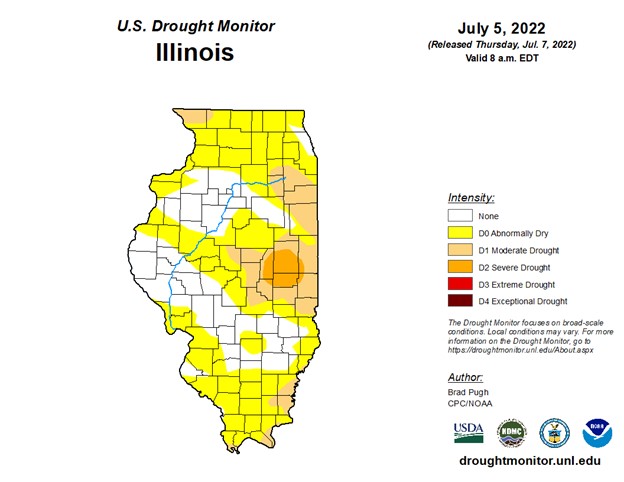Issue 6, July 8, 2022
Monitoring and Mitigating Drought Stress in the Landscape
Water is essential for plants. Without water, a plant begins to experience stress, whether reduced growth, cupping leaves or curling, or turning brown. Drought stress also inhibits physiological plant functions, increasing susceptibility to pests and other sources of injury. Drought-stressed plants tend to be more susceptible to climate extremes, insects, plant pathogens, animals, and nutrient deficiencies.
The U.S. Drought Monitor is an excellent resource that provides interactive drought maps and statistics at the national, state, and county levels. You can use this resource to determine how well your area is doing with soil moisture.
https://droughtmonitor.unl.edu/CurrentMap.aspx
https://www.drought.gov/states/illinois
You may or may not be surprised to learn that roughly 68% of Illinois is currently under varying degrees of drought. Most of that area is categorized as abnormally dry, with smaller areas categorized as moderate to severe drought.

Here are some tips to help mitigate drought stress in the landscape if these dry conditions persist or worsen.
- Mulch: A 2-4" deep layer of mulching will help to moderate soil temperatures and conserve soil moisture. Be sure to maintain a small mulch-free space near the bases of plants.
- Control Weeds: Pull any weeds that may compete with desirable plants for moisture, nutrients, and growing space. Mulch will also help control weeds that may compete with desirable plants for soil moisture.
- Avoid fertilizing dormant or drought-stressed plants.
- Irrigate. Newly planted trees, shrubs, and perennials are extremely susceptible to injury from drought. Most trees and shrubs will benefit from one inch of water per week applied in one slow, thorough soaking. It is important to water slowly because this allows the water to soak deeper into the soil.
- Let your lawn go dormant. Turfgrasses have an excellent dormancy mechanism that allows them to tolerate most droughts. However, even dormant turfs require some water. If the drought extends beyond six weeks, it is wise to lightly irrigate your turf with approximately ¼" of water every two weeks.
Authors:
Travis Cleveland
Maria Turner